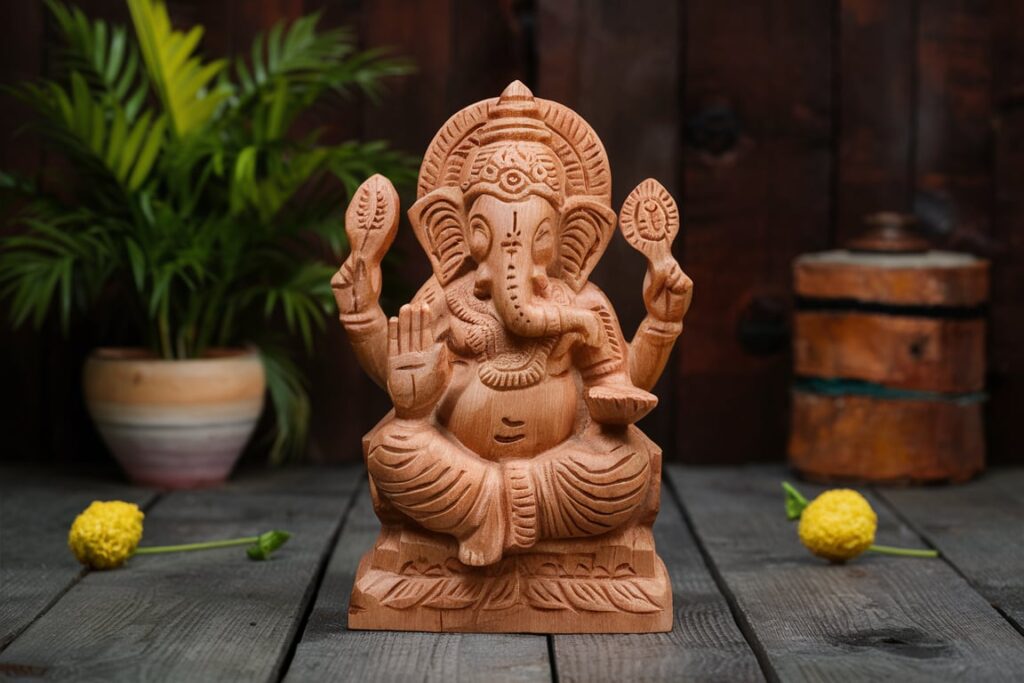India’s artistic tradition has long included wood carving, as seen by the stunning Keralan landscape and the spectacular Khajuraho temples. Each location has unique roads and trails that give the trees life and inspire artistic creations.

As we take you on a tour around this blog, we will discuss the characteristics of Indian woodwork, the tedious procedure that goes into it, and how you can bring a little bit of this rich tradition into your home.
A Legacy Carved in Wood: A Historical Perspective
Wood carving has been a long-standing art form in India. Craftsmen in the Indus Valley Civilization (3300–1300 BCE) fashioned wooden bracelets and beads, as evidenced by archaeological finds. For this art form, the Gupta Dynasty (c. 320–550 CE) was its peak. Skilled artisans adorned the most artistic temples, like those in Khajuraho and Konark, with exquisite sculptures depicting gods, legendary animals, and floral motifs.
Regional styles developed over time as a result of local materials, customs, and aesthetic preferences. Every region evolved its own visual language, ranging from the intricate floral decorations of Nagina to the geometric patterns of Kashmir.
A Tapestry of Techniques: Exploring Different Types of Wood Carving
India’s vast cultural landscape translates into a diverse range of wood carving styles. Let’s delve into some of the most prominent ones:
- Relief Carving: This technique involves creating raised figures or designs against a flat background. The depth of the carving can vary, from shallow bas-relief to deep high-relief. Temple doorways, furniture panels, and decorative objects often utilize this method.
- Inlay Work: This elaborate technique involves incorporating contrasting elements, including metal, ivory, or priceless stones, into carved wooden surfaces. With its delicate floral inlays, the Taj Mahal is a magnificent example of this art.
- Lacquerware: This vibrant style involves applying multiple layers of colored lacquer onto carved wood, often creating intricate designs. It’s particularly notable in the lacquerware tradition of Kerala.
- Filigree Carving: This delicate technique involves creating intricate openwork patterns using fine chisels. It’s commonly seen in furniture embellishments and decorative objects, particularly in the sandalwood carvings of Karnataka.
- Architectural Carving: India’s temples, palaces, and traditional homes frequently include exquisite architectural carvings. These have beautifully carved beams, windows, entrances, and pillars that highlight the artistic and structural possibilities of wood carving.
The Hands that Shape Wood: The Process of Wood Carving
The creation of a wooden masterpiece involves a time-honored process passed down through generations. Here’s a glimpse into the steps involved:
- Selection of Wood: The type of wood chosen depends on the desired outcome. Teak, sandalwood, rosewood, and shisham are popular choices due to their durability, texture, and grain patterns.
- Seasoning: Skilled artisans season the wood properly to eliminate moisture and prevent warping or cracking after carving.
- Sketching and Design: The artist sketches the design directly onto the wood or creates a template for guidance.
- Roughing Out the Shape: Using basic tools like chisels and saws, the artisan removes excess wood, giving the piece a rough form.
- Refining the Details: Finer chisels and gouges are used to create intricate details and patterns.
- Finishing: The artisan meticulously sands the carved piece smooth before polishing it to enhance its beauty and protect the wood. Depending on the chosen style, additional finishing touches like paint or lacquer might be applied.
Great talent, determination, and an aesthetic sense are needed throughout the entire procedure. Every piece of carving bears witness to the commitment and skill of Indian artists.
Bringing the Art Form Home: Owning a Piece of Indian Wood Carving
India’s temples, palaces, and traditional homes frequently include exquisite architectural carvings. These have intricately carved beams, windows, entrances, and pillars that highlight the artistic and structural possibilities of wood carving.
Bringing a bit of India’s rich history and artistic talent into your living environment is the true meaning of owning an Indian wood carving, which goes beyond simply purchasing a beautiful item. These handcrafted gems infuse any home with a dash of cultural flair and timeless charm.
In a Nutshell
Discover the fascinating selection of Indian wood carvings offered by Tanutra right now! Experience the enchantment of these handcrafted items and infuse your house with a dash of heritage and artistry. Go through our inventory on our website, www.tanutra.com, to discover the ideal item for you.
